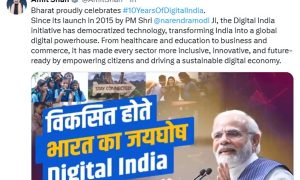By Priya Vasudevan – It was lunch break at the gender diversity & inclusion workshop I was facilitating. The participants, a bunch of women rapidly trooped towards the factory cafeteria. We were discussing excitedly the company’s new Gender diversity & Inclusion policy and there was a sense of optimism, sorority and confidence. As the women reached the entrance of the cafeteria, they slowed down, hesitated, cast their eyes down and stooped. There were men everywhere in the cafeteria! This incident prompted me to look at Gender equality at – Self and System level. If this is the state of women in organized educated sector imagine the truly marginalized.
Modi Govt has identified citizens at the intersection of the disparity dimensions like backward areas, poor, women etc and created systemic interventions in the form of policy changes. Over the last few decades there has been alarming decrease in the Child Sex Ratio (CSR) and the Sex Ratio at Birth (SRB) . Low SRB is indicative of female feticide and Low CSR is indicative of female infanticide – sadly excluding women from life itself. Reasons for disparity are many – extreme poverty, lack of education, even family food habits – with the more nutritious food being given to male child, socio-cultural beliefs…..the list goes on.
The Beti bachao beti padhao scheme was architected with the unique overall goal of Celebrating the girl child and enabling her education. The key elements of the scheme include enforcing Prevention of prenatal sex determination, nation-wide gender awareness and advocacy campaign and multi-sectoral action in select 100 districts lowest on child sex ratio. Emphasis is on mindset change through training, sensitization, awareness raising and community mobilization on ground. Within a year and a half, due to strong enforcement and sensitization Haryana improved its Sex ratio at birth to 950!
Similarly, women in the rural hinterlands of India have been silently toiling in their kitchens inhaling the deadly firewood smoke – reducing their health and life expectancy. The much lauded Ujjwala yojana of the Narendra Modi Govt succeeded in giving 2 crore LPG connections to poor women.
Again Sukanya samridhi yojana secures the future of young girls. Under this scheme over 1 crore accounts have been opened and over 11 Crore rupees have been deposited into these accounts. The perceived financial burden to raise a girl child has been eased by the Govt. The training centers under Pradhan Mantri Kaushal Vikas Yojana has imparted training in 375 trades to over 22 lakh youth and 50% of candidates are women. Under the MUDRA scheme collateral free, low interest rate loans have been availed almost 70% have been by women entrepreneurs.
Modi government has facilitated System level policies to nurture women, in doing so the government is the first one in recent times – working boldly on a core social element, the external patriarchy which is deeply entrenched in our society at a conscious as well as unconscious level. It is often the patriarchy that disempowers the women.
While the System level changes are happening, women need to rise and confront their own inner selves – a world where an inner patriarch lives on. The inner patriarch is the disempowering beliefs and self-talk that affirm the negative gender discourse prevailing in the society. This is perhaps the last mile of reforms.
Hopefully, the bunch of women walking into a male dominated factory cafeteria will not slow down and stop – they will hold their held high and proudly enter……..
- Priya Vasudevan (the author works on gender issues in society and organizations)
- The author can be fallowed on priyavasudevan @uniquepv




























 WhatsApp us
WhatsApp us